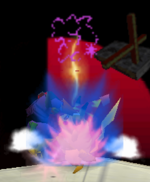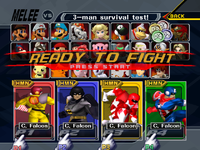File replacement: Difference between revisions
Ninelevendo (talk | contribs) m (→Moveset hacks) |
|||
| Line 33: | Line 33: | ||
===Moveset hacks=== | ===Moveset hacks=== | ||
[[File:IkeisCloud.png|thumb|The vertices of {{SSBB|Ike}}'s model, his moveset, and even animations have all been altered to turn him into ''{{s|wikipedia|Final Fantasy VII}}'' protagonist, {{s|wikipedia|Cloud Strife}}.|250px|right]] | [[File:IkeisCloud.png|thumb|The vertices of {{SSBB|Ike}}'s model, his moveset, and even animations have all been altered to turn him into ''{{s|wikipedia|Final Fantasy VII}}'' protagonist, {{s|wikipedia|Cloud Strife}}.|250px|right]] | ||
Created by Phantom Wings, moveset hacks (known as "Project Smash Attacks" after the [[Project Smash | Created by Phantom Wings, moveset hacks (known as "Project Smash Attacks" after the [[Project Smash Attacks|identically-named program]], as well as "Plan Zeroes" after the first notable moveset hack) alter the movesets of an individual character to varying degrees. This type of hack, however, requires extensive knowledge of scripting and floating values in order to perform, though multiple tutorials exist in an attempt to teach newer users on how to perform such hacks. The first notable moveset hack was "Plan Zero", a moveset hack of {{SSBB|Mario}}. Although not the most popular moveset hack, it became the most widely known amongst hackers after the release of Project Smash Attack. Today, most moveset hacks are more refined than before, and often feature famous characters such as Cloud Strife from ''Final Fantasy VII'', Waluigi, and [[Mewtwo]], who was eventually hacked into ''[[Project M]]''. | ||
==External links== | ==External links== | ||
Revision as of 09:05, September 22, 2014
File replacement is a general term used to describe replacing various elements of the games in the Super Smash Bros. series, including textures, music, and even movesets. Initially holding niche appeal amongst gamers, improvements to the hacking scene, especially for Brawl, have led to more and more sophisticated file replacement hacks for the games. A majority of game mods for the games feature extensive use of file replacement hacks in order to deliver a unique experience to the mod.
In Smash 64
File replacement in Smash 64 is accomplished by the use of the Rice Video plugin in conjunction with an emulator. The lesser fanbase of Smash 64 is the primary reason why this type of file replacement is less common than for the other two games; additionally, Rice Video has been implicated in causing stability problems with Super Smash Bros. with certain hardware and emulators
Owing to an inability to design cartridges for the Nintendo 64, no effective way has been found to replace files and use the modified ROM on an actual console.
In Melee
Largely untouched for the first nine years since the game's release, file replacement in Melee gained popularity when S. of Stack Smash posted his texture hacks online. This process entails replacing files directly to the ISO with a program such as GC-Tool, and then burning the ISO to a disc or saving the ISO on a computer so that it can be run with an emulator such as Dolphin.
Due to the difficulty in hacking the GameCube console by itself, the difficulty in reliably accessing the Wii's RAM for playing GameCube games, and the steep system requirements of Dolphin, file replacement in Melee is considerably less widespread than that for Brawl, though it does have a few devoted developers. Improvements in Dolphin itself have allowed for more hacks to be produced for the game, with Melee: SD Remix featuring numerous changes the game's stages via file replacement.
In Brawl
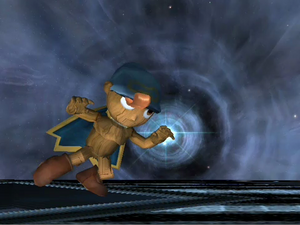
Due to the ease of hacking the Wii through the use of the Homebrew Channel, the lack of technical expertise in getting the Homebrew Channel and replacement files, the ability to hack a Wii because of the Smash Stack exploit, and a wide variety of resources available for it, file replacement is the most popular in the Brawl community, with many websites available solely for downloading a variety of hacks for the game. Brawl hacks are also known for being among the most sophisticated of the three games, with all-new character movesets and unique stages even being introduced to some mods; programs like BrawlBox and Open SA also exist to assist in the creation of file replacement hacks.
Brawl hacking was initially restricted to particularly devoted players, as hacking the game's files initially required the extensive use of modified ISOs and Wii consoles in order to run hacked data. Hacker Phantom Wings is credited to expanding the popularity of Brawl file replacement hacks, as he made file replacement available to users using SD cards, with most prior file replacement hacks requiring hacking of the Brawl ISO itself.
Specific hacks
Texture hacks
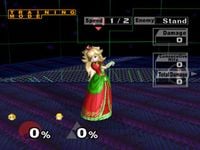
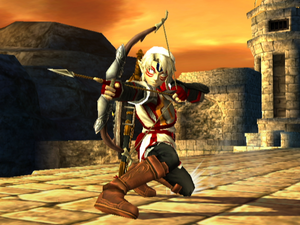
Texture hacking refers to the modification of individual textures in the game's data. Pioneered by the hacker Pharrox, a majority of texture hacks are cosmetic in function, and often take the form of alternate costumes for characters, such as those seen in the images to the left and right. Textures from both characters and stages can be modified, as can various other texture; some hacks, for instance, replace the graphics featured in Peach's Peach Blossom. Particularly extensive texture hacks are also often featured in moveset hacks, such as those seen in Project M and Brawl-.
Music hacks
Music hacks feature the replacement of unpopular music tracks and replacing them with tracks that the user prefers to use in the game. Custom music was popularized by GHNeko (one of the main developers of Brawl+), who made a video displaying various stages with custom music, although it was done with a modified ISO. Eventually, Phantom Wings continued his file replacement code used for textures to incorporate music (the first post about it can be seen here). Initially difficult for casual users to understand, due to the use of the .brstm file and requiring music to loop in an acceptable manner, fellow hacker Bionic Sonic created a tool that required considerably less hacking and editing from the end user's part. The hacker Dantarion later improved on this method.
Moveset hacks
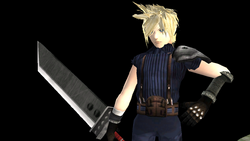
Created by Phantom Wings, moveset hacks (known as "Project Smash Attacks" after the identically-named program, as well as "Plan Zeroes" after the first notable moveset hack) alter the movesets of an individual character to varying degrees. This type of hack, however, requires extensive knowledge of scripting and floating values in order to perform, though multiple tutorials exist in an attempt to teach newer users on how to perform such hacks. The first notable moveset hack was "Plan Zero", a moveset hack of Mario. Although not the most popular moveset hack, it became the most widely known amongst hackers after the release of Project Smash Attack. Today, most moveset hacks are more refined than before, and often feature famous characters such as Cloud Strife from Final Fantasy VII, Waluigi, and Mewtwo, who was eventually hacked into Project M.
External links
- Smashboards Smash 64 hacking guide
- Smashboards Melee hacking introduction
- A guide to using the File Replacement code for users using the SD loader
- Brawl Vault, which hosts numerous Brawl-related texture hacks
- Kitty Corp: Meow Mix, a texture hack team.
- Elite Smash Hackers, a blog concerning file replacement hacks
- Stack Smash, a resource for hacks
